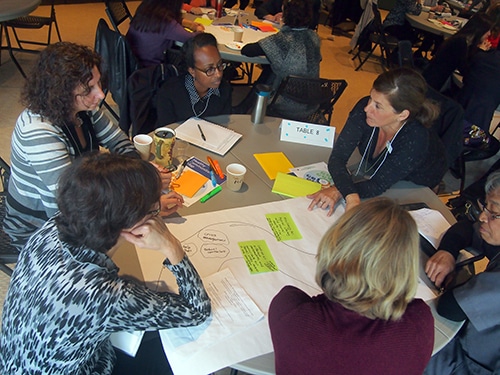By Meghan Pritchard, BHK, MPH, Community Health Specialist, Surrey and Burnaby
On October 9 the Burnaby Healthier Community Partnership hosted a workshop about finding the links between mental health, physical activity and physical literacy. This workshop was delivered in partnership with the BC Healthy Communities Society on behalf of the PlanH Program.
The audience of over 40 participants represented service providers and program planners from the Healthier Community Partnership (City of Burnaby, the Burnaby School District, Fraser Health Authority), and a variety of community groups. The Burnaby Healthier Community Partnership includes City of Burnaby, Burnaby School District and Fraser Health Authority.
The Workshop
The workshop helped people see the synergies between promoting mental and physical health. The workshop also helped participants see the value of focusing on upstream initiatives in this work.
The day opened with a welcome from City Councillor Paul McDonell who spoke about the importance of working collaboratively throughout the community to promote health and wellness for all residents of Burnaby. He was followed by the Medical Health Officer for Burnaby, Dr. Lisa Mu, who described the current demographics for Burnaby and shared some insight into the current health status of Burnaby residents. After Dr. Mu’s presentation, Senior Social Planner for the City of Burnaby, Margaret Manifold, described the work that has been done to date through the Burnaby Healthier Community Partnership.
During the workshop, participants were asked to consider why physical activity, physical literacy and mental health matter to Burnaby. They were given the opportunity to identify a “sticky issue” that makes it challenging to work together to promote mental and physical wellness in Burnaby. A range of ‘sticky issues’ were identified, including inequities in our society and a perceived lack of appreciation for the importance of maintaining good physical and mental health.
Participants considered what they were doing in their own organizations, and what their next steps would be in collaboration with those around them at the workshop. For each sticky issue, tangible next steps were identified and a commitment was made to continue to conversation, with the understanding that conversation and communication leads to opportunities for collaboration.
One particularly important comment from a participant who works with youth in the area of substance use was that it can be difficult for people who are working downstream at the point of intervention to think upstream towards prevention. These service providers are so often overwhelmed with trying to reach all of the people who need help now that they cannot find time or energy to work on upstream issues. This reinforced for participants the importance of the whole community taking ownership of a problem and not expecting one service provider to work in both intervention and prevention at the same time.
The Partnership
In January 2014 Burnaby launched its Healthy Communities Partnership (HCP). The partnership involves the City of Burnaby, the Burnaby School District and the Fraser Health Authority. The HCP identified mental health and physical activity/literacy as their main focal areas. As work in these areas progressed, it became clear that they could not be viewed as separate topics and there would be benefit from bringing the two committees together, along with members of the wider community who are working in these areas. As a result, the HCP applied for the PlanH Dialogue to Action workshop in order to discuss how different health and service organizations throughout the community could collaborate to promote health and wellness.
The HCP presents a model of how different sectors can work together, using their existing resources, to advance shared goals of enhancing the health and wellbeing of people in the community. By creating a formal venue for communication, they can easily identify opportunities for collaboration and collective action. Creating this formal communication system was a critical component of their model.
The most valuable resources are the people who have local knowledge of the community and the needs of the population. By sharing this knowledge more broadly, we are able to see the bigger picture of what is happening in our community. As a collective they have also been able to apply for grants that support the work.
People can visit the Fraser Health website to learn more about the Healthy Communities Partnerships in Fraser Health region.
photo courtesy Peer-Daniel Krause




